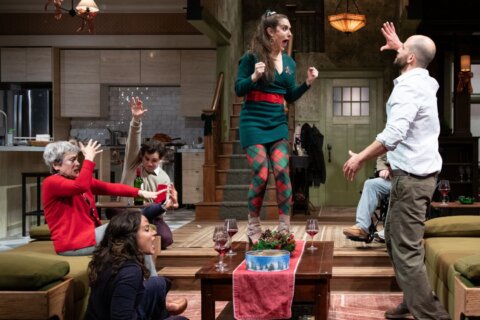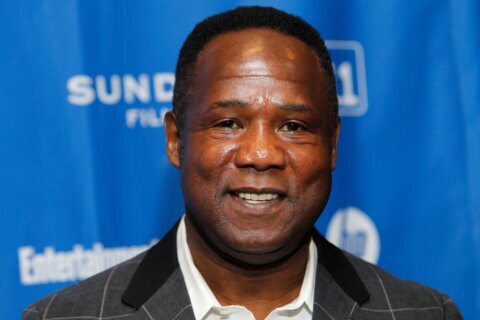What would happen if you felt so ignored that you actually became invisible?
That’s the fascinating premise of the new movie “Above the Shadows,” written and directed by D.C. filmmaker Claudia Myers, who is also a film professor at American University. The film opens in select theaters and is available on streaming Friday.
The premise is a cross between “Rocky” (1976) and “Ghost” (1990), following Holly (Olivia Thirlby), who has become invisible to her father (Jim Gaffigan) and the rest of the world after the death of her beloved mother (Maria Dizzia). Now, she must find her way back with the help of the one man who can see her, Shayne (Alan Ritchson), who just happens to be a disgraced MMA fighter with a socialite ex-girlfriend (Megan Fox).
“This is just the way the story came to me,” Myers said. “It was inspired by my childhood. I guess at the time, invisibility didn’t feel like a metaphor, it felt like a very tangible state of existence. So that was kind of the jumping-off point for me writing a story about a girl who was literally invisible and yet functions normally in the world. … Ultimately what I was really exploring was how do we break out of the prism of our own experience?”
Raised in France, Myers came to America to attend Yale University before getting her M.F.A. in film at Columbia University. Her thesis short film “Buddy & Grace” (2001) played at the Sundance Film Festival, earning her a chance to direct her debut feature, the romantic comedy “Kettle of Fish” (2006), starring Matthew Modine and Gina Gershon.
After that, she wrote and directed the indie war drama “Fort Bliss” (2014), starring Michelle Monaghan, Ron Livingston and Oakes Fegley, while writing the road-trip comedy “Wild Oats” (2016), starring Shirley MacLaine, Jessica Lange and Demi Moore.
Now, three decades after Moore’s “Ghost,” Myers is diving into her supernatural genre.
“There’s a supernatural premise, but it’s really grounded,” Myers said. “How does she pay rent being invisible? How does she make a living? How does she get her groceries? All of that’s in the film and that’s part of the fun of it. Working with Olivia, it was identifying what her state of mind is. She has no one to talk to, it’s such a lonely existence, but there’s a mundane quality. She takes the bus because she can’t hail a cab and can’t drive a car.”
While she has directed military action before, it was an education filming the MMA fights.
“Tito was really helpful on set,” Myers said. “Alan Ritchson trained for about six weeks, learning basic MMA skills. He’s really athletic to begin with, but he trained every day for six weeks. We designed the fights well ahead of time, so he learned the choreography. He was doing all of that in L.A. then came to New York and got a chance to rehearse with the various scene partners since there are three different fight scenes in the film.”
The fight scenes were shot mostly in Queens, as well as at the Borgata in Atlantic City.
“One of the biggest challenges of a small indie film was how do we pull off these larger fight sequences?” Myers said. “We actually shot one of the fight scenes during a live event, which was a pretty wild experience because we got a real crowd who was there to see an actual fight, then we put our actors in the cage during the commercial break. It was such a great experience, the actors fed off that energy and I think it shows.”
Not only are the fights exciting, the grappler is battling a similar desire to be seen.
“They’re mirror characters,” Myers said. “He was a fighter in the spotlight. That’s where he wants to be again. They’re yearning for their version of acceptance and validation. … It’s constructed like a fairy tale, but in reality, it’s about taking the focus away from wanting to be seen and actually seeing others. That’s what the movie is actually about.”
Aesthetically, what sort of visual language did she construct?
“It’s definitely a stylized world,” Myers said. “Some of my references were images from graphic novels. … She’s a reluctant superhero with this power that she doesn’t want. … So creating a world that felt out of time, an iconic version of Manhattan, the dark alleys, the jewel-colored nightclubs. … There’s a contrast between the flashbacks when her mother was alive and the world as she knows it, which is cold, dark and full of shadows.”
She also uses a kaleidoscope as a “familiar image” device.
“The kaleidoscope is a central image,” Myers said. “It has a function in the plot, but it is also a symbol where you take the same shapes, rearrange them and you get a whole new pattern. When you watch the film, you’ll understand the importance of that concept.”
The production ran 21 days and included 26 locations across Manhattan, Queens and Brooklyn. You might think such a hectic schedule is hard to balance with her teaching load, but Myers has mastered the juggling act for the past 11 years at American University, where she is currently the co-head of the fiction side of the film program.
“I took a sabbatical to shoot ‘Above the Shadows,'” Myers said. “I see myself remaining on the faculty at American University. That’s my academic home. I love making movies, but I couldn’t imagine making a movie a year or being on set all the time. That doesn’t suit my lifestyle, it doesn’t work for my family. I really enjoy the balance of making a film then teaching as a way to re-center myself and to challenge myself in a different way.”
She also feels that it helps her to be selective.
“It allows me to be choosy about what I do,” Myers said. “I can develop projects that are meaningful to me and that I have a real passion for. … Having the luxury of having a stable position in a community of other creators, I think I’m really lucky.”
Can other people make movies based out of D.C. rather than head to L. A.?
“If you want to be a staff writer, you need to be in L.A., but for people who want to be writer-directors, screenwriters or direct D.C.-based stories, I not only don’t see a reason to run out to L.A., I think there’s an argument that you stand out more not being from there. … The films I’ve made, the stories I’ve encountered, the projects I’m developing, I would have never come across if I didn’t live here. … I think it’s completely doable.”
Editor’s Note: Claudia Myers was one of Jason’s film professors at American University.
Find out where you can stream the movie here.








